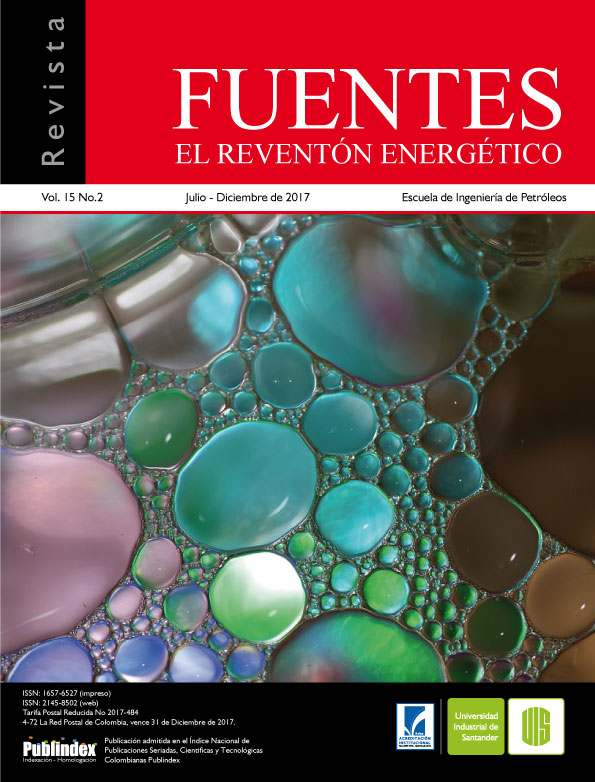Fine-tuning pvt correlation for some colombian crude oil
Published 2017-12-15
Keywords
- Correlation Optimization,
- Viscosity,
- Density,
- Volumetric Factor
How to Cite
Abstract
The accurate estimation of reservoir fluid properties as a function of temperature and pressure depicts a key step in the procedure of developing a correct well flow model. The strictest model currently applied uses the Equations of State (EOS), by a detailed description of the fluid composition and assigning certain properties for each component. One generalized approach so called Black-Oil model considers the reservoir fluid as mixture of three phases: water, oil and gas, which generally regards only the dissolution of gas in water and oil, but the liquids are immiscible. Both approaches use adjusting of experimental PVT tests to mathematical expressions. Generally, model developing effort is related to the purpose of the fluid model and production mechanism, nevertheless in bottom and surface well level cases (not for reservoir level), the estimation is simplified using empirical correlations based on Black-Oil model which have been widely used and several authors develop them. These correlations lack in extrapolated conditions. In this work, the results of fine tuning methodology through different correlations optimization to PVT properties of four Colombian crude oils (Castilla and Chichimene as heavy and extra-heavy oils, and other more lighter crudes such as Apiay and Yariguí), whose API gravities are between 7 to 30°. Experimental PVT data test and other conditions such as well surface data and expected performance are used to obtain expressions which achieve good representation of fluid properties in typical well operational conditions. These expressions are useful for other fluids with comparable properties than the fluid used for adjusting, for instance well fluids of the same field.
Downloads
References
2. Al-Marhoun, M. A. (2004). Evaluation of empirically derived PVT properties for Middle East crude oils. Journal of Petroleum Science and Engineering, 42, 209-221.
3. Almehaideb, R. A., Al-Khanbashi, A. S., Abdulkarim, M., & Ali, M. A. (2000). EOS tuning to model full field crude oil properties using multiple well fluid PVT analysis. Journal of Petroleum Science and Engineering, 26(1-4), 291-300.
4. Avaullee, L., Duchet-Suchaux, P., & Durandea, M. (2001). A new approach in correlating the oil thermodynamic properties. Journal of Petroleum Science and Engineering, 30(1), 43-65.
5. Banzer S., C. (1996). Correlaciones Numéricas P.V.T. Maracaibo, Venezuela: Fundación laboratorio de Servicios Técnicos Petroleros.
6. Dindoruk, B., & Christman, P. G. (2004). PVT Properties and vicosity correlations for gulf of Mexico oils. SPE Anual Technical Conference and Exhibition, New Orleands, USA, SPE 71633.
7. El-Sebakhy, E. A. (2009). Forecasting PVT properties of crude oil systems based on support vector machines modeling scheme. Journal of Petroleum Science and Engineering, 64(1-4), 25–34.
8. Elsharkawy, A. M., Elgibaly, A. A., & Alikhan, A. A. (1995). Assessment of the PVT correlations for predicting the properties of Kuwaiti crude oils. Journal of Petroleum Science and Engineering, 13(3-4), 219-232.
9. Frashad, F., LeBlanc, J., Garber, J., & Osorio, J. (1996). Empirical PVT Correlations For Colombian Crude Oils. Society of Petroleum Engineers, SPE-36105-MS. doi:https://doi. org/10.2118/36105-MS
10. García Chinchilla, C. A. (2009). Diseño conceptual del sistema de recoleccion de crudo extrapesado San Fernando. Bucarmanga, Colombia: Tesis de Maestría en Hidrocarburos, Escuela de Ingeniería de Petróleos - Univrsidad Industrial de Santander.
11. Godefroy, S., Hiang, S., & Emms, D. (2012). Comparison and validation of theoretical and empirical correlations for black oil reservoir fluid properties. Offshore Technology Conference (pp. 1-26). Houston, USA: Offshore Technology Conference .
12. Jaubert, J. N., Avaullee, L., & Souvay, J. F. (2002). A crude oil data bank containing more than 5000PVT and gas injection data. Journal of Petroleum Science and Engineering, 35(1-4), 65-107.
13. Mohammed, A. M., & Muhammad, A. A.-M. (1996). Evaluation of empirically derived PVT properties for Pakistani crude oils. Journal of Petroleum Science and Engineering, 16(4), 275-290.
14. Muhammad, A. A.-M. (2004). Evaluation of empirically derived PVT properties for Middle East crude oils. Journal of Petroleum Science and Engineering, 42(2-4), 209-221.
15. Olusanya, S. O., Selamat, A., & Raheem, A. A. (2010). Modeling PVT Properties of Crude Oil Systems Using Type-2 Fuzzy Logic Systems. In Computational Collective Intelligence. Technologies and Applications Lecture Notes in Computer Science (pp. 499-508). Kaohsiung, Taiwan: Springer Berlin Heidelberg.
16. Omar, M. I., & Todd, A. C. (1993). Development of new modified black oil correlations for Malasyan crudes. SPE Asia Pacific Oil & Gas Conference & Exhibition, Singapore, SPE 25338.
17. Singh, K., Fevang, O., & Whitson, C. H. (2007). Consistent Black-Oil PVT table modificaction. Society of Petroleum Engineers, SPE 109596, 1-13.
18. Vega Moreno, S. M., & Martínez Jaimes, J. P. (2012). Análisis y desarrollo de modelos de fluidos asociados a la simulación numérica de procesos de combustión in situ. Bucarmanga, Colombia: Universidad Industrial de Santander.
19. Velarde, J. J. (1996). Correlation of Black Oil Properties At Pressures Below The Bubble- Point. Texas, USA: Texas A&M University.
20. Velarde, J., Blasingame, T. A., & McCain Jr., W. D. (1997). Correlation of Black Oil Properties at Pressure Below Bubble Point Pressure - A New Approach. Annual Technical Meeting Petroleum Society of Canada (PETSOC-97-93). Alberta, Canada.
21. Wu, R., & Rosenegger, L. (1999). Comparison of PVT Properties from Equation of State Analysis and PVT Correlations for Reservoir Studies. CSPG and Petroleoum Society Join Convention, Digging Deeper, Finding a Better Bottom Line (pp. 1-6). Alberta, Canada: Petroleoum Society Journal.
